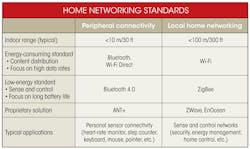According to a variety of publications, industry analysts, and industry experts, the smart home market is set to explode over the next few years. Why? Just look at ZigBee’s success.
Very similar to Wi-Fi, and often considered the low-power version of Wi-Fi, ZigBee is an international standard that is accepted worldwide. It is recognized as a reliable, robust, and cost-effective solution for connecting the world of smart-home sentrollers (sensors that measure data and are smart enough to take action based on what’s reported) to local remote controls and to the cloud to provide monitoring and management via smart phones and smart devices.
Related Articles
- The Smart Home Versus The Really Smart Home
- OSF Will Speed Up ZigBee's Adoption In The Smart Home
- Cable Companies Will Deliver The Smart, Automated Home
This movement toward the ZigBee standard is led by the various device makers and equipment OEMs as well as by the cable companies and services providers. Today, leading large multi-service operators (MSOs) are driving smart-home applications via a variety of innovative service offerings like security, energy management, and home care. The number of smart-home devices connecting to the Internet is steadily growing by several millions per month. ZigBee has already been selected as the preferred technology by a number of service providers, such as Comcast, DirecTV, Time Warner, and EchoStar.
This file type includes high resolution graphics and schematics when applicable.
Advantages Of Standards
Large and small technology and consumer electronics manufacturing companies want worldwide solutions—individual technologies that can be sold and shipped anywhere in the world. Manufacturers hate having to develop and certify different products (and different SKUs) for different regions in the world. Having to create and track various types of products, targeting different geographic markets, is a logistical hassle that most companies want to avoid as much as possible. Managing different voltages and power cords is already enough.
Open standards, with multiple chip and technology providers, guarantee the lowest costs and continuity of supply. Standards give OEMs the freedom to purchase from a larger pool of suppliers and with competitive pricing. They also enable common technologies that ease design decisions and inventory requirements. Most importantly, international standards allow devices from different vendors to interoperate, which is paramount in communications products that are marketed and used worldwide.
These “peace-of-mind” goals make large companies big supporters of open, international standards. Without standards, it would be difficult to have machines or equipment efficiently co-operate. It would be expensive to develop workarounds to make gear talk to each other. Systems can be very complex, so every element of a large system that can be standardized essentially removes a significant uncertainty factor out of the complexity of the total system or, at least, isolates it and makes it manageable.
The challenge with standards, though, is that they usually take a long time to finally come together. But once they are completed, the compromise best fits everyone’s interests. For wireless sentroller communications for the smart home, one standard has overcome the negotiations and delays to prevail today: ZigBee.
ZigBee Versus Wi-Fi For The Smart Home
There are two open IEEE-based standards for Smart Home networking: Wi-Fi and ZigBee. Wi-Fi primarily is used for content sharing and distribution. ZigBee targets low-data-rate sense/control applications, with a focus on battery life. In addition, there are two open Bluetooth SIG-based standards for connecting peripheral devices: Bluetooth “Classic” for content (such as connecting audio to a phone) and Ultra Low Power Bluetooth “Smart” for sense and control (such as adding a heart-rate monitor to a phone or a watch).
In addition to these open standards, two proprietary technologies have hit the market as pre-cursors to the open standards: ZWave (in the U.S.) and EnOcean (in Europe). Only one technology provider offers these technologies, though. ZWave and EnOcean are sub-gigahertz, regional, quick to market technologies, while most of the industry is embracing open worldwide standards like Wi-Fi, ZigBee, and both flavors of Bluetooth (see the figure).
Proprietary solutions usually disappear from the market, just as HomeRF disappeared in favor of Wi-Fi, because it is very difficult for proprietary technologies to cost-effectively compete. Proxim’s HomeRF was a proprietary standard and a pre-cursor to Wi-Fi, but it fell out of favor once Wi-Fi developed momentum as an open worldwide standard.
The ZigBee Standard
IEEE 802.15.4 provides the first open standard for wireless sentroller applications. It offers the fundamental lower network layers for a type of wireless personal-area network (WPAN) focusing on low-cost, low-speed ubiquitous communication between devices. On the next communications layer, the ZigBee standard supplies a superior solution for the rapidly evolving and growing smart-home and Internet of Things (IoT) market.
With more than 400 members, the ZigBee Alliance maintains and publishes the ZigBee standard for wireless communication for a wide variety of application domains including home, consumer, smart energy/grid, building automation, and retail automation. All of these ZigBee protocols use the same underlying radio technology. They also use the same 2.4-GHz frequency band worldwide and comply with worldwide radio certification rules.
ZigBee is often described as the low-power Wi-Fi. What Wi-Fi provides for computers and televisions in distributing content through the home, ZigBee provides for small devices and gadgets such as light switches, thermostats, remote controls, security sensors, door locks, and motion sensors.
The key characteristic for ZigBee is its long battery life. As it only needs to transmit tiny data packages, ZigBee allows applications to run on batteries for many years. It also supports energy harvesting, so a battery might not be needed at all. For example, imagine a wireless light switch that can be powered by simply flipping the switch. No battery is required because flipping the switch generates enough energy to enable its ZigBee radio to send a signal across the room to an individual light, making it turn on or off.
In short, ZigBee is the standard of choice for low-power networking and ideal for smart-home applications, and its adoption is rapidly accelerating.
History Repeats Itself
When it comes to technology standards, history provides a valuable lesson. Today, Wi-Fi and Bluetooth are worldwide accepted open standards (based on IEEE 802.11 and 802.15.1). But a little over a decade ago, Wi-Fi and Bluetooth underwent a few years of market confusion, where they were pitted against each other and had to compete with proprietary alternatives.
Today, Wi-Fi and Bluetooth dominate the wireless networking and communications market, each in its own application domain. Wi-Fi has become the technology for high-speed, high-data-rate communications in our homes and throughout larger buildings, while Bluetooth has become the standard short-range, low-data-rate “cable replacement” technology connecting a wide range of devices from keyboards and mice to headsets and speakers.
When the market confusion finally is resolved, ZigBee and Bluetooth Smart will dominate low-power networks. ZigBee will be used for networked devices and sentrollers (e.g., smart-home solutions), and Bluetooth Smart will be the answer for simple one-to-one connections.
Cees Links is the founder and CEO of GreenPeak. Under his responsibility, the first wireless LANs were developed, ultimately becoming household technology integrated into PCs and notebooks. He also pioneered the development of access points, home networking routers, and hotspot basestations. He was involved in the establishment of the IEEE 802.11 standardization committee and the WiFi Alliance. And, he was instrumental in establishing the IEEE 802.15 standardization committee to become the basis for ZigBee sense and control networking.


